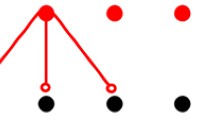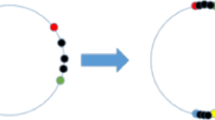Abstract
In detailed simulations we present a coordinated delayed feedback stimulation as a particularly robust and mild technique for desynchronization. We feed back the measured and band-pass filtered local filed potential via several or multiple sites with different delays, respectively. This yields a resounding desynchronization in a naturally demand-controlled way. Our novel approach is superior to previously developed techniques: It is robust against variations of system parameters, e.g., the mean firing rate. It does not require time-consuming calibration. It also prevents intermittent resynchronization typically caused by all methods employing repetitive administration of shocks. We suggest our novel technique to be used for deep brain stimulation in patients suffering from neurological diseases with pathological synchronization, such as Parkinsonian tremor, essential tremor or epilepsy.
Similar content being viewed by others
References
Alberts WW, Wright EJ, Feinstein B (1969) Cortical potentials and parkinsonian tremor. Nature 221:670–672
Batschelet E (1981) Circular statistics in biology. Academic Press, London
Benabid AL, Benazzous A, Pollak P (2002) Mechanisms of deep brain stimulation. Movement Disorders 17:73–74
Benabid AL, Pollak P, Gervason C, Hoffmann D, Gao DM, Hommel M, Perret JE, de Rougemount J (1991) Longterm suppression of tremor by chronic stimulation of ventral intermediate thalamic nucleus. The Lancet 337:403–406
Brown P, Oliviero A, Mazzone P, Insola A, Tonali P, Lazzaro VD (2001) Dopamine dependency of oscillations between subthalamic nucleus and pallidum in parkinson’s disease. J Neurosci 21:1033–1038
Dolan K, Witt A, Spano ML, Neiman A, Moss F (1999) Surrogates for finding unstable periodic orbits in noisy data sets. Phys Rev E 59:5235–5241
Hauptmann C, Mackey MC (2003) Stimulus dependent onset latency of the inhibitory recurrent activity. Biol Cybern 88:459–467
Hellwig B (2000) A quantitative analysis of the local connectivity between pyramidal neurons in layers 2/3 of the rat visual cortex. Biol Cybern 82:111–121
Kuiper NH (1960) Test concerning random points on a circle. Proc K Ned Akad Ser A: Math Sci 63:38–47
Kuramoto Y (1984) Chemical oscillations, waves, and turbulence. Springer, Berlin Heidelberg New York
Morris C, Lecar H (1981) Voltage oscillations in the barnacle giant muscle fiber. Biophys J 35:193–213
Neiman AB, Russell DF (2004) Two distinct types of noisy oscillators in electroreceptor of paddelfish. J Neurophysiol 92:492–509
Nini A, Feingold A, Slovin H, Bergmann H (1995) Neurons in the globus pallidus do not show correlated activity in the normal monkey, but phase-locked oscillations appear in the MPTP model of parkinsonism. J Neurophysiol 74:1800–1805
Nunez PL (1981) Electric Fields of the brain. Oxford University Press, New York.
Pinsky PF, Rinzel J (1995) Synchrony measures for biological neural networks. Biol Cybern 73:129–137
Pyragas K (1992) Continuous control of chaos by self-controlling feedback. Phys Lett A 170:421–428
Richardson K, Gluckman BJ, Weinstein SL, Glosch CE, Moon JB, Gwinn RP, Gale K, Schiff SJ (2003) In vivo modulation of hippocampal epileptiform activity with radial electric fields. Epilepsia 44:768–777
Rinzel J, Ermentrout GB (1989) Analysis of neural excitability and oscillations. In: Koch CH, Segev I (ed.) Methods in neuronal modelling from synapses to networks. MIT, Cambridge, MA, pp 135–169
Rosenblum MG, Pikovsky AS (2004) Controlling synchronization in an ensemble of globally coupled oscillators. Phys Rev Lett 92:114102
Tass PA (1999) Phase resetting in medicine and biology. Springer, Berlin Heidelberg New York
Tass PA (2002a) Desynchronization of brain rhythms with soft phase-resetting techniques. Biol Cybern 87:102–115
Tass PA (2002b) Effective desynchronization with bipolar double-pulse stimulation. Phys Rev E 66:036226
Tass PA (2003a) A model of desynchronizing deep brain stimulation with a demand-controlled coordinated reset of neural subpopulations. Biol Cybern 89:81–88
Tass PA (2003b) Stochastic phase resetting of two coupled phase oscillators stimulated at different times. Phys Rev E 67:051902
Tass PA, Russell DF, Barnikol U, Neimann A, Yakusheva T, Hauptmann C, Voges J, Sturm V, Freund H-J (2005) Selective disruption of neural synchronization by means of repeated transient phase reset. (submitted)
Terman D, Rubin JE, Yew AC, Wilson CJ (2002) Activity patterns in a model for the subthalamopallidal network of the basal ganglia. J Neurosci 22:2963–2976
Traub RD, Miles R (1991) Neural networks of the hippocampus. Cambridge University Press, Cambridge
Volkmann J (2004) Deep brain stimulation for the treatment of parkinson’s disease. J Clin Neurophysiol 21:6–17
Volkmann J, Joliot M, Mogilner A, Ioannides AA, Lado F, Fazzini E, Ribary U, Llinás R (1996) Central motor loop oscillations in parkinsonian resting tremor revealed by magnetoencephalography. Neurology 46:1359–1370
Yeung MKS, Strogatz SH (1999) Time delay in the Kuramoto model of coupled oscillators. Phys Rev Lett 82:648–651
Author information
Authors and Affiliations
Corresponding author
Rights and permissions
About this article
Cite this article
Hauptmann, C., Popovych, O. & Tass, P.A. Effectively desynchronizing deep brain stimulation based on a coordinated delayed feedback stimulation via several sites: a computational study. Biol Cybern 93, 463–470 (2005). https://doi.org/10.1007/s00422-005-0020-1
Received:
Accepted:
Published:
Issue Date:
DOI: https://doi.org/10.1007/s00422-005-0020-1




